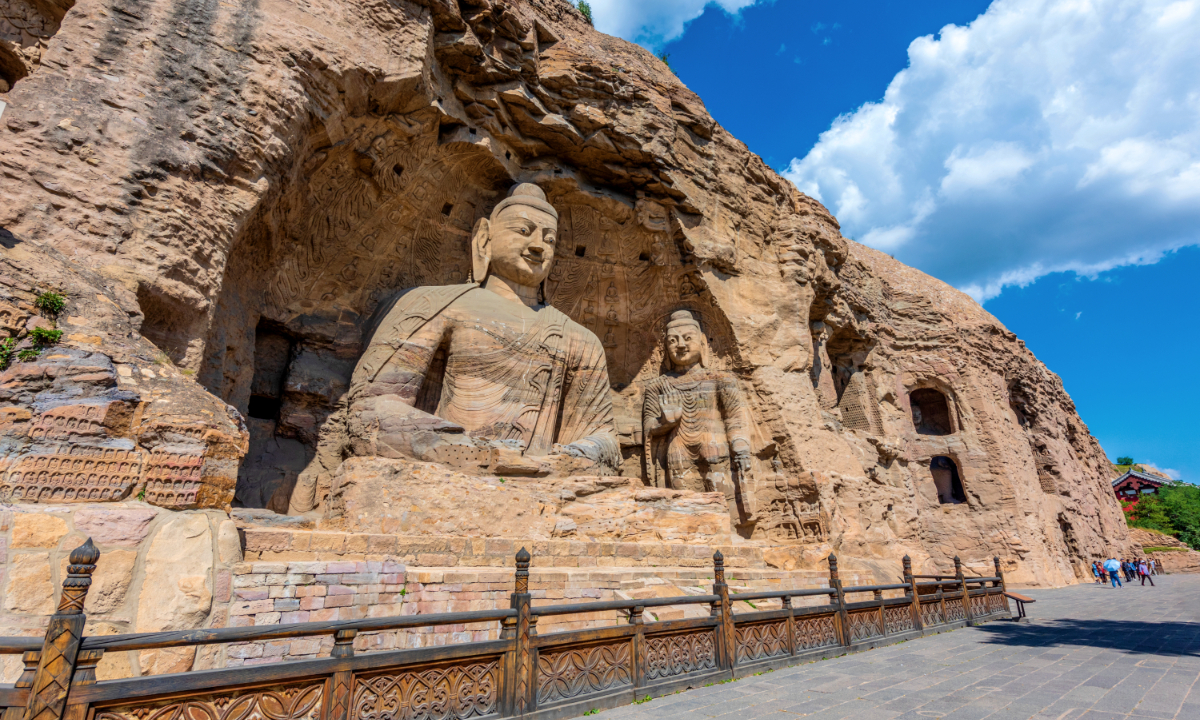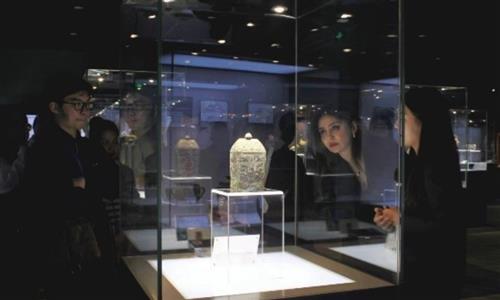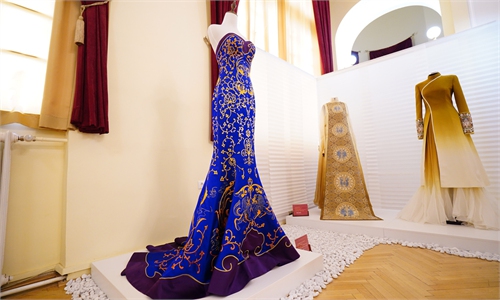ARTS / CULTURE & LEISURE
Yungang Grottoes witnesses of cultural exchanges
Yungang Grottoes witness of Silk Road

The giant stone-carved Buddhist statue (left) of Grotto No.20 and a cultural icon of the Yungang Grottoes Photo: VCG
The Yungang Grottoes, located in Datong, North China's Shanxi Province, are one of the three most famous grottoes in China. With a history of 1,500 years, they are known for their imposing statues, number of relics and fine carvings. The site, which includes 45 main grottoes with a total of 51,000 statues in them, has been included in the list of World Cultural Heritage by UNESCO.
The stone-carved sculptures come in a wide range of sizes. The biggest is 17 meters tall, and the smallest is just a few centimeters tall. The most representative of these are masterpieces during the first peak of Chinese Buddhist art after Buddhism was introduced to China from India in the Han Dynasty (206BC-220), such as Grottoes No.3, No. 6 and No. 20.
Magnificent statues
Grotto No. 3 is the largest grotto in Yungang. In its rear chamber sit three statues of Buddha. The middle one, also the biggest, is 10 meters tall. His body is caved with good proportions and features a closely fit Kasaya on it. The two side statues are six meters tall and their hair is finely carved in orderly strands that reach the shoulders, an example of exquisite design and mature carving skills.
Grotto No. 6 is symmetrically designed around a central axis, and its walls are evenly divided into two levels. This is the most magnificent, completely designed, and best-preserved grotto in Yungang. It features a 14-meter-tall pagoda-pillar in the middle of the chamber with two levels going straight to the ceiling. On the upper part of the pagoda-pillar stand four Buddhas, and its interior contains eight Bodhisattvas facing the Buddhas. The relief sculptures on the lower part depict a dozen stories from the life of Sakyamuni. According to initial statistics, the grotto comprises a total of 2,900 Buddhist statues of various images and patterns.
Compared with other grottoes in China, the Yungang Grottoes are characterized by both a Buddhist style that was introduced from India and a gradually Chinese style. In Grotto No. 20 the Indian influence is particularly evident. The 13.7-meter-tall statue of Buddha sitting on a stone platform features a straight nose, deep-set eyes, and a mustache above his thin lips. His upright body is dressed in a heavy kasaya that leaves bare its right shoulder. Since the wall in front of it collapsed, the complete statue is exposed in the open air. The whole statue is so intricately and smoothly carved that it looks awesome, magnificent and vital. It is undoubtedly the most representative statue of Buddha and a cultural icon of Yungang, a masterpiece that clearly shows the exchanges of the Chinese and Indian civilizations through the ancient Silk Road.
Starting point of Silk Road
It is generally known that Xi'an (known as Chang'an in ancient times) was the starting point of the Silk Road. But broadly speaking, the early Silk Road began in the Han Dynasty and had several starting points based on the capitals of the dynasties before Tang Dynasty(618-907). According to historical records and relics unearthed such as Persian silver ware and glass ware, Datong, formerly called Pingcheng, capital of the Northern Wei Kingdom(386-534) was also a starting point of the Silk Road. During this period, people from Central Asia, including foreign envoys, officials, merchants, monks, artisans and musicians, resided in Datong, a city which during the Northern Wei period embodied the flourishing international trade and cultural exchanges along the Silk Road. The Yungang Grottoes were a witness of the Silk Road culture in the Northern Wei period.
Digitalized protection
Yet over the years the Yungang Grottoes have seen some damages due to weathering, and a few images cannot be seen clearly anymore. Main protection operations have been ongoing over the past decades, starting from the founding of the People's Republic of China. In 1961, the Yungang Grottoes were listed as cultural heritage under state protection. In the 1970s, a massive three-year national project for the Yungang Grottoes was put into practice for the first time. The project included building protective walls, consolidating some grottoes as well as paving with geotechnical cloth to prevent water seepage from the ceilings.
In the 1990s, the economic development of Datong posed some challenges to the protection work. A national road, 350 meters away from the Yungang Grottoes, used to be packed with heavy traffic: Trucks of coal, the main resource of Shanxi, went back and forth incessantly. Under these circumstances, the government allocated 260 million yuan (35.52 million US dollars) to build a new 30-kilometer road, about 1,500 meters away from the historical site, and converted the original one into a special tourist route, according to a report from China.com.cn.
In the 2012, the Yungang Grottoes Research Institute reinforced the rock bodies from Grotto No. 9 to 13, restored their painted murals and built protective eaves. In recent years, advanced technology has been applied in its restoration, such as reinforcing the damaged rock masses, the digital modeling of typical grottoes and the construction of a three-dimensional information system, making the protection of the Yungang Grottoes enter a new stage. In addition, local researchers have also cooperated with experts in China's renowned universities to set up the Yungang digital center, and have gathered the data of half of the grottoes to promote the high-tech digitalization of the Yungang studies.



